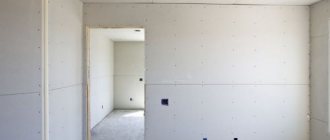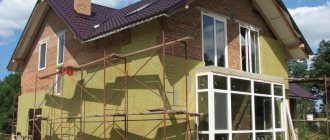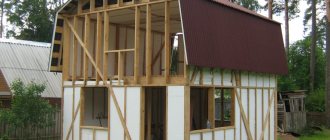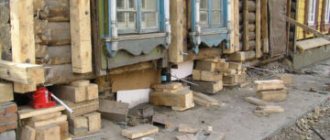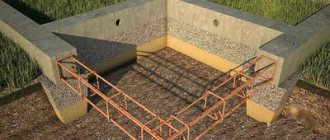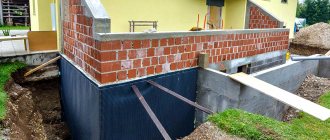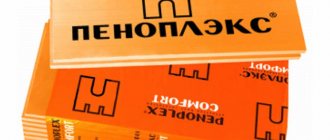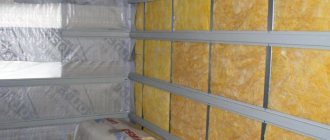A wide selection of materials is available for cladding the façade plinth.
Options for the best way to decorate the foundation base of a private house beautifully and cheaply are discussed in the article.
How to cover the foundation of a house from the outside cheaply and beautifully: materials, photos, prices
There is no point in indicating the specific cost of each solution, since prices for materials, as well as specialist services, differ in different regions. But you can consider budget solutions that allow you to solve the issue at the lowest possible cost:
- Basement siding is made of PVC and is not afraid of moisture and temperature changes. Suitable for both strip and pile foundations, as it can be mounted on a wooden or metal frame. The most important advantage: the work is easy to do yourself, which saves money.
- Flat slate is another cheap material that works well for plinths; it can be used to quickly level the surface and create bases for any type of finish. This option is not considered the safest, but when used outdoors it is unlikely to harm the health of residents.
- Corrugated sheeting can be used to cover the foundation. The material is durable and easy to use, but the appearance of the structure will not be the most attractive. Therefore, this solution is most often used for country houses, outbuildings and other structures where the aesthetic component is not very important.
- Coloring. You can simply paint the base if the surface is more or less flat. Minor unevenness and damage can be plastered or puttied. For the job, it is worth choosing high-quality paint that creates a moisture-proof layer on the surface.
- Plastering. If the house has a strip foundation or a block base, you can finish it with a plaster compound to protect it from adverse influences and give it an attractive appearance. It is best to use compounds with pigment that do not need to be painted, then the work can be done in one go.
By the way!
The base should be finished as early as possible so that the structure does not become saturated with moisture and deteriorate. In the case of a pile foundation, this is not so important, but in this case the appearance of the house without finishing will not be very attractive.
Types of base
When choosing the material and method of finishing the base, it is necessary to take into account its design. There are three arrangement options:
- Speaker. Suitable for walls of small thickness. It is necessary to additionally install a drip to drain water flowing from the walls.
- Flush with the wall. In this case, there is a possibility of condensation forming in the house.
- Sunken. In this case, the wall of the first floor is wider than the base
1- wall of the house. 2 - low tide. 3 - base.
Experts believe that a sinking base of a house is the most durable. The drainage system is designed in such a way that the foundation remains untouched.
Beautiful
Beautiful options for finishing the base:
Lining the base with artificial stone.
Clinker tiles.
Options for finishing the base of a wooden house.
Inexpensive
If the budget is not large, then the following materials can be used to decorate the basement of the house:
- OSB, DSP boards;
- decorative panels;
- siding.
Plaster
Suitable for concrete surfaces, block structures and other prefabricated elements. The work can be done independently, but if you need to create a certain structure, it is better to practice beforehand. If you don’t know how to cover the strip foundation of a house from the outside cheaply and beautifully, then this solution will be optimal, as it has many advantages:
- Availability. The price of plaster compositions is low; they can be bought at any hardware store.
- Easy to apply. To work, you will need a container for preparing the mixture, a trowel and a small rule for leveling the surface. All features of the process are indicated on the packaging.
- Short terms of work. Finishing the foundation of an average-sized home can be completed in a day.
- Possibility of painting the surface in a suitable color.
There are also disadvantages that are worth considering:
- You need to purchase special plaster; regular façade plaster will begin to crack in a couple of years.
- The surface must be dry and clean, so work cannot be carried out during wet periods.
- If the foundation has significant unevenness, the consumption of plaster increases greatly.
If necessary, you can first fix the thermal insulation material; extruded polystyrene foam is best suited. And a reinforcing mesh must be laid on top of the sheets.
Waterproofing
The life of the house depends on the quality of the basement waterproofing. The foothills are influenced by multiple negative factors - melting snow, groundwater. To prevent the building from starting to collapse prematurely, it should be reliably protected. The outside of the basement requires the most attention. The structure should be protected in two planes at once:
- Vertical. Apply moisture-repellent mixtures and materials;
- Horizontally. Rolled layers are laid between the outer part of the base and the foundation.
Depending on the type of soil, depth of groundwater, climate and other factors, choose the appropriate option for vertical waterproofing. This can be a special protective varnish, bitumen mastic, liquid polymers, synthetic resins. Also, the external facade can be covered with roofing felt. When choosing a waterproofing method, you should take into account the type of material from which the base is built and the finishing features. There are several options for protective cladding:
- Penetrating. After application, the cement-quartz mixture slowly moves along microcracks deep into the concrete, tightly clogging them. The material becomes chemically inert, its strength increases by 30%;
- Rolled. Apply to any basement structures. For reliability, it uses 2-3 polymer, bitumen, synthetic layers. The rolls are glued overlapping, providing very high protection against moisture. The joints are lubricated with water-repellent mixtures;
- Coating. Apply several layers of liquid mastic to the prepared surface. Bitumen, cement-polymer mixtures are not durable and require protection from external physical influence. After 5 years they require replacement;
- Screen. The base is finished with special overlapping clay panels and nails are attached to the dowel;
- Brick protection. Waterproofing should be considered at the material procurement stage. The brick must be treated with protective impregnations. Coating impregnation is applied to the cleaned surface of such a base and covered with roll insulation.
Concrete
The so-called decorative concrete is facing elements in the form of bricks, tiles or natural stone. They are attached to the base with an adhesive composition and not only transform it, but also serve as additional protection from adverse influences. The main advantages are:
- Low price. Products made from lightweight concrete are much cheaper than other facing materials.
- Ease of use. You can carry out the work yourself; no special qualifications are needed.
- Possibility of painting in any color, although the elements can be with the addition of pigment.
As for the disadvantages, we can highlight the following:
- Concrete absorbs moisture, which is undesirable, so the surface should be treated annually with a special protective agent.
- The size of the products is small, so cladding can take a lot of time.
Important!
When using decorative concrete, it is important that the base is dry. To improve adhesion, be sure to treat it with a special primer.
Peculiarities
The protruding part of the foundation, in contact with the facade of the building, is constantly exposed to various types of influences:
- Chemical. Atmospheric precipitation, dirt, reagents fall on the surface;
- Biological. The foundation is partially located in the ground and interacts with organisms living in the soil;
- Physical. Daily, seasonal changes in temperature, air humidity;
- Mechanical. Blowing by winds that carry different grains of sand.
In view of these circumstances, the increased load experienced by this part of the building, it must be protected. The choice of materials for cladding, as well as the work itself, should be approached thoroughly, taking into account the following requirements that raw materials for finishing must meet:
- Moisture resistance. The material must reliably protect the wall from rain, snow, condensation, so that moisture cannot get onto the surface of the base or penetrate through the finish. Otherwise, this may lead to the destruction of not only the base of the building, but also its facade. In humid environments, fungus and mold often appear, which cause an unpleasant odor.
- Resistance to mechanical damage. The stone or tile must have a high level of strength; together with the transitional part, they hold the entire load created by the walls of the structure and distribute it evenly over the base.
- Thermal conductivity. Allows you to retain heat in the house and serves as additional insulation.
- Immunity to temperature changes. Due to the properties of the material to shrink and expand as a result of temperature fluctuations, cracks may appear on the surface of the cladding, which will lead to a decrease in resistance to moisture, frost resistance, and subsequently to the destruction of raw materials.
Siding
Covering the outside of a house with special siding is a simple solution that allows you to make the foundation more attractive in a short time. The panels can imitate stone or brick and are matched to the style of the facade. The main advantages are:
- Siding is the easiest to work with. The panels are lightweight, easy to attach and join, there are corners and other additional elements.
- For installation, a wooden or metal frame is constructed. You can put heat or waterproofing material under it.
- Suitable for both strip and pile foundations, as it is attached to the frame and not to a solid surface.
Plastic panels for the plinth also have certain disadvantages:
- When fastening, it is important not to tighten the screws to the end, leaving a gap for thermal expansion. If you overlook this, the material may crack.
- At sub-zero temperatures, the panels become brittle and can be damaged even by a slight blow.
Siding does not allow moisture to pass through, but if it gets behind it, it will not let it out. Therefore, it is important to secure a reliable flashing on top to drain water.
Work rules
There are general recommendations that must be followed when performing finishing activities:
- The side surfaces must be vertical.
- If the base is protruding, then there should be a slope on its upper cut. This will make it possible to install an ebb, along which the liquid will flow down without affecting the side surfaces.
- The important part is the preliminary preparation. Before finishing the surface, you need to clean it, sand it and treat it with an antiseptic. If it is very uneven, a coat of primer will be required.
Compliance with these simple rules is a guarantee that the foundation of the structure will be as strong and durable as possible.
Profiled sheet
It is made of galvanized steel with a polymer or paint coating. The base made of corrugated board lasts a long time, but at the same time it looks simple and unpretentious. It has many advantages:
- You can choose not a plain option, but a profiled sheet that imitates stone, wood or other material; it looks much better.
- It is not difficult to attach the sheets with your own hands; the process is very similar to installing siding; it also uses lathing.
- The weight of the finish is light and, if necessary, it can be easily dismantled.
As for the disadvantages of corrugated sheets, the most significant of them are the following:
- Low sound and heat insulation characteristics. It is advisable to use mineral wool or polystyrene foam under the metal.
- When the protective layer is damaged, the steel begins to rust.
Important!
It is better to cut profiled sheets with a jigsaw. If you do this with a grinder, the metal overheats and begins to rust at the ends.
Pre-dry styling
This is the next stage of preparation before finishing the base with natural stone with your own hands. It consists of making a drawing or mosaic. For greater accuracy, you can first draw a sketch on paper, marking all the lines, boundaries and shapes. It is best to lay out the stone on a clean, dry area, adjusting the elements to fit and filling the gaps with small pieces of stone. This technology will allow you to display the desired pattern as accurately as possible and adjust its shape and size. If it is necessary to adjust the size, you can use a 125 or 150 mm grinder, installing a circle on it for cutting stone. How to do this correctly - watch the video for the lesson.
At this stage, it is necessary to take into account the technological gaps between artificial and natural stone. The stone should not be laid end to end, maintaining a distance of at least 3-5 mm on each side. This technology allows you to avoid distortion of the upper rows of stone and compensate for thermal expansion. This way the installation will always remain level. When facing with natural stone, wide joints and large gaps between large stones can be filled with small pieces. In this case, the stones should be glued to the base with the smooth, even side, and not vice versa.
Fake diamond
An excellent solution for a foundation that is not afraid of changes in temperature and humidity. There are a lot of options, so choosing the right one for any facade will not be difficult. The advantages are:
- Long service life of tens of years. In terms of strength, artificial stone is almost as strong as natural stone.
- Attractive appearance, such a base looks respectable.
- Possibility of self-installation. The stone is glued in the same way as ceramic tiles, everything is quite simple.
Among the disadvantages it is worth highlighting the following:
- The high price of the material, it is an order of magnitude more expensive than everything that was discussed earlier.
- Demanding requirements for the base: it must be level.
In general, this option is suitable for those who value reliability. It is enough to carry out the work once - and you can forget about finishing the foundation for at least 10 years.
Facing with boulders or small cobblestones
It is not necessary to buy a boulder or cobblestone. You can collect it on a river or on a pebble beach at sea. Rolled stones are chosen to be flatter - round ones are more difficult to “mount”. The procedure and all other subtleties are almost the same as in the case of finishing with natural stone. The only difference is that these stones must be washed in water and detergent before use. Firstly, the water in our ponds may have oils in it and need to be removed, and secondly, there may be clay or algae in it which can cause the finish to fall off.
To make everything look organic, you can first lay out a “picture” of cobblestone cladding on the path next to the place where you will cladding the base. They have different shades and their random combinations are not always attractive. By laying everything out side by side you will have an idea of what the end result will be.
Watch the video about the features of finishing the plinth with cobblestones.
Gabions
This element is not often used for foundations, but it looks original and is not very expensive. The structure is a frame made of mesh, inside of which crushed stone or pebbles are poured. The main advantages are:
- You can design both strip and pile foundations. In the second case, the mesh frame should be more durable.
- The stones are simply poured in and lightly compacted. Most of the time is spent on installing the frame.
- The appearance is original, this is rare.
Gabions also have disadvantages:
- They are quite thick and can stick out strongly relative to the facade.
- They allow water and cold to pass through; it is advisable to lay hydro- and heat-insulating materials from the inside.
By the way!
This is how you can design the foundation of a fence or any other structure.
Porcelain tiles
Durable finishing material that is suitable for foundations and provides their reliable protection. Available in different colors and item sizes may vary. The advantages are as follows:
- The cladding looks respectable and fits well with most facades.
- Installation does not cause any particular difficulties and is no different from tiling surfaces with ceramic tiles.
- The service life is long, with proper installation it can last for decades.
As for the disadvantages, they are:
- The price of the products is high; they are an order of magnitude more expensive than most types of finishes for the base.
- It is very important to lay the elements perfectly evenly, otherwise the appearance will not be the best.
Porcelain stoneware is suitable not only for foundations, but also for formwork, as it is not afraid of water. The main thing is to prepare the base and lay the elements at a slight slope.
Need for finishing
Since the base of a private house is located above the ground, according to standards its height should be at least 20 cm. It is constantly in sight and is subject to various types of influences, so its cladding plays an important role and allows you to solve a number of problems, namely:
- If you leave the surface of a protruding foundation without covering, then under the influence of dirt, precipitation, aggressive chemicals and organic substances, it will slowly collapse.
- The correct choice of materials that correspond to the general style of the building will transform the building, give it the best look, and turn it into a masterpiece of design art.
- The finishing protects the foundation of the structure from damage by mold, mildew, and prevents the access of insects and rodents.
- Tile, stone, and plaster retain heat well, allow the building to be insulated, and also protect the supporting structure from frost, preventing erosion.
Clinker tiles
An excellent solution for walls and foundations, as clinker is durable. In addition, this finish looks attractive and goes equally well with different facades. The main advantages are as follows:
- A huge selection of options, differing in color and texture. You can find almost any shade.
- Long service life. The resource is at least 20 years.
- Low maintenance, the surface does not require the application of protective compounds, although moisture protective agents will not hurt.
Clinker tiles also have some disadvantages:
- High price. This is one of the most expensive solutions.
- Difficulty in installation. The small size of the tiles complicates the process.
Important!
In order for the work to go quickly, you need to level the base as best as possible.
Planning
How and where to start facing? Decide on the area of work, measure the length and width of the outer part of the base with a construction tape, and multiply the values. The result is the finishing area. Add 12% for fitting and trimming. The amount of finishing material required is obtained.
The construction market offers a wide variety of finishing: plaster (mineral, silicate, silicone), siding and PVC, brick, corrugated board, clinker tiles, stone (artificial or natural).
Despite the high cost, facing the foundation with natural stone will be the best option. It is durable, resistant to temperature changes, tested by nature itself; in “weak” places it has already cracked. Wild stone can be called eternal.
Types of facing natural stone:
There are differences in thickness and color. The most affordable is thin, a couple of centimeters, gray sandstone. It will also be the easiest. When laying it, only cement mortar is used. Red, green, blue colors are more expensive. The cost of thick, heavy stone is significantly higher.
Tip: When choosing a stone, wet its surface. The color of the wet rock will be identical to the color of the varnished finish.
Painting
Painting is only suitable for already plastered surfaces or block foundations that do not require finishing. A simple solution that has many advantages:
- Takes minimal time. The work is carried out with a roller; for joints and other difficult places, a brush is used.
- The choice of paints is simply huge; in the store they can choose any shade that is needed.
- You can refresh the color or change it at least every year.
Coloring also has some disadvantages:
- It does not hide surface flaws; if the foundation is uneven, it will be visible.
- It is necessary to prepare the base - clean it from dirt and apply a primer, otherwise the paint may peel off.
It is best to use special paints with moisture-repellent properties. But at the same time they must be vapor permeable.
Conclusion
The choice of material for the base largely depends on the design features of the latter, as well as your individual preferences and financial capabilities. It is necessary to take into account that the quality of the cladding is influenced not only by the type of cladding, but also by compliance with the technology of its installation. Therefore, the work should be carried out in accordance with the above recommendations (see also the article “Finishing a wooden house with siding with your own hands - features of the technology”).
You can find additional useful information on the topic discussed above from the video in this article.
Slate
A flat version is used, which allows you to quickly create a flat surface. Slate is good because it is easy to use and affordable; it can be bought almost anywhere. The advantages of this solution are:
- Low price: slate is one of the most inexpensive materials today.
- Suitable for both strip and pile foundations.
- The surface can be painted or covered with plaster.
There are also disadvantages:
- When cutting, a lot of harmful dust is generated.
- For painting you need to use special roofing paint, which is expensive.
Important!
Slate can be glued to any suitable composition or attached to the frame with self-tapping screws, having previously drilled holes.
Preparatory stage
There are several ways to lay a natural stone foundation.
In any case, pre-clean the surface. Excess dry mortar is removed and the seams are cleaned if the base is brick. The swells on the concrete foundation are cut down. The surface is washed, if necessary, degreased and dried. Primed with concrete contact, applied with a brush, roller or spray gun. It is better to choose a ready-made primer with a coarse-grained fraction, which will increase the adhesion of the finishing material to the surface. Approximate consumption: 250 g. per square meter. Allow 7 hours to dry completely. Operate at temperatures from +5 to +35°C.
Tip: The primer significantly reduces its quality when dust settles on it. Therefore, they treat the area with which they will directly work. For greater reliability, the base can be covered with a fine metal mesh.
Beautiful options with photos
It’s worth looking at a few more solutions that are not included in the review, but are often used when finishing foundations in private homes:
- Thermal panels. An option that combines attractive exterior finishing and insulation. Allows you not only to transform the base, but also to insulate it at the same time.
- Facing bricks are suitable for making the base of a pile foundation. This not only makes the base attractive, but also creates a durable structure that will last for decades.
- A natural stone. Expensive, but durable finish that will not lose its attractiveness even after 20 years. You can choose different types of stone, the appearance of the structure depends on this.
- Bayramiks. Marble chips, which are applied in a thin layer to the surface and create a durable moisture-proof barrier due to an acrylic-based adhesive composition. Looks great, but requires careful preparation of the base.
- Terrace board. A composite material based on wood raw materials that is not afraid of water and lasts for many years. It is easy to install, the appearance is attractive and is perfect for buildings in a modern style.
Finishing the base is necessary not only to improve the appearance, but also to protect the base from adverse influences. You should select the material based on your budget and structural features; if necessary, the surface is thermally insulated.
Why is the base covered?
Many people believe that plinth cladding is only needed to decorate the house beautifully. Indeed, the beautiful finishing of the base, combined with the facade, gives the house visual appeal and individuality. But this is not the only purpose of the plinth sheathing.
Foundation cladding performs a number of other important functions:
- Protection from environmental influences. Precipitation, temperature changes, exposure to sunlight - all this violates the integrity and strength of the foundation.
- High humidity and pollution can lead to the formation of stains, the development of fungal growths, and mold. Insects settle in the cracks that appear.
- The basement of the wall is subject to constant contamination. Under the influence of the chemicals contained in it, erosion and destruction of the surface begin.
Experts recommend not only finishing the base, but also insulating it well.
Insulating the base will protect the foundation from freezing. Under the influence of low temperatures, even the strongest concrete begins erosion processes that will reduce its strength.
Also, the frozen base is a bridge for the transfer of cold. The walls and floor of the first floor will be cold, which will affect the temperature in the house.
The arrangement of the basement is carried out even if the house is built on a pile foundation. In this case, a false base is arranged. It protects the space under the house from wind and cold, retaining heat.
